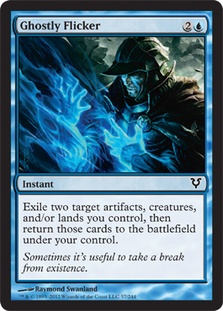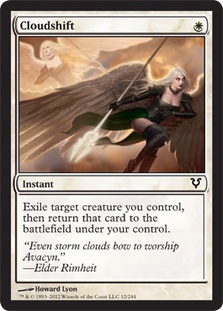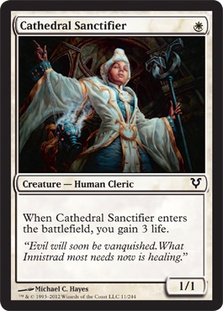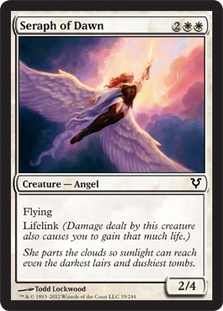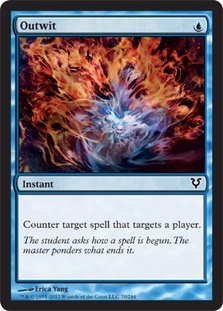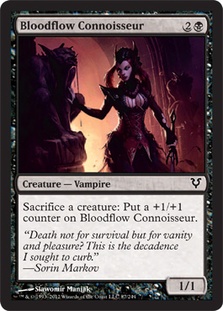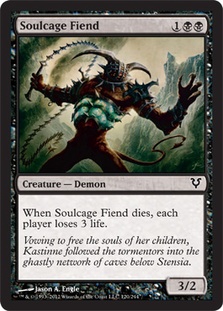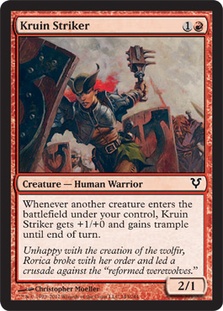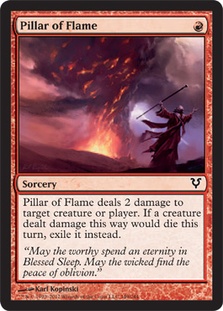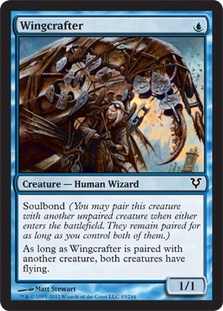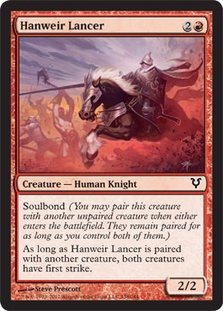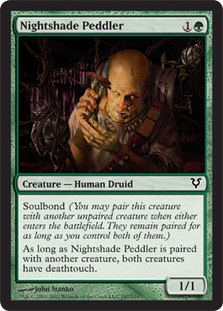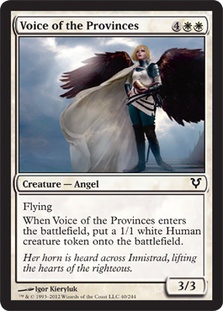The Helvault is open, and while the Angels of Avacyn Restored are flying high into the skies of Innistrad, there’s an army of commons littering the ground around the ruin. The barrier for entry into Pauper is high; as the format draws upon the entire history of Magic for its card pool, breaking into established archetypes is difficult. Avacyn Restored does contain some options for decks that already exist, but it gives the real juice to a consistent fan favorite.
Almost without fail, one of the first decks anyone wants to build when they first hear about Pauper is a deck featuring various black Rats and Ninja of the Deep Hours. I mean, who doesn’t want to play this deck? Not only do they have to discard because of your Ravenous Rats, then you get to draw a card thanks to Ninja (who blocks?)! Oh, and they have to discard again when the Rats come back. As the new common mage scours old sets, Cavern Harpy comes to light—even more value…and it flies! How can I lose?
The answer is always consistency. The Ninja-Rats deck is potent, making great use of Pauper’s enters the battlefield creatures, and utilizes two of the format’s best colors. But it’s two colors, which is a death knell for many Pauper decks. On top of this, the deck doesn’t have the ability to close out games with Corrupt, as its black sibling can.
Avacyn Restored does bring something new: Ghostly Flicker. Replacing Ninja of the Deep Hours and Cavern Harpy, Ghostly Flicker is not net loss in tempo and can also pull off tricks that were formerly only available to decks splashing Momentary Blink, namely negating a draw at instant speed with a Rat on the board. Flickering a Chittering Rats on a draw step is one of the most satisfying/back-breaking plays in Magic. Here’s a shell for such a deck:
Creatures (24)
- 4 Ravenous Rats
- 4 Chittering Rats
- 2 Phyrexian Rager
- 2 Mesmeric Fiend
- 4 Mulldrifter
- 4 Spellstutter Sprite
- 4 Liliana's Specter
Lands (24)
Spells (12)

Sure, it lacks the end game of Corrupt. But Ghostly Flicker and Unearth provide a stream of advantage, and Mulldrifter is a finishing move unto itself.
In the same vein is Cloudshift. Half of a Momentary Blink is still fairly good. In the early days of Pauper, certain Rats decks adopted a secondary Nightsky Mimic gameplan that would allow for turn 2 4/4 lifelink creatures (Nip Gwyllion and Edge of the Divinity) or aforementioned Mimics coming over the top. With the release of Kor Skyfisher, these decks went more Rats but eventually vanished, again likely due to the rough mana. Some of these decks tried to survive by shoehorning in Momentary Blink and an Island splash for flashback. With Cloudshift, is this still necessary?
Creatures (22)
Lands (24)
Spells (18)

This deck shares many aspects with the Dimir version, but the mana is smoother and the "splash" is lighter. It also is a hair more aggressive, which could hinder the long-term plan (the lack of Mulldrifter shows).
Dangerous Wager and Mad Prophet are two cards that build on the basis of Faithless Looting. In August, I discussed Tortured Existence based decks, as designed by E Hustle, and provided a Rakdos style of the deck (which can be viewed in this article). The master of Tortured Existence is at it again, obtaining a winning record in multiple dailies with this list:
Creatures (25)
- 3 Carrion Feeder
- 2 Mesmeric Fiend
- 2 Golgari Brownscale
- 4 Stinkweed Imp
- 2 Mogg War Marshal
- 2 Gathan Raiders
- 3 Grave Scrabbler
- 4 Fume Spitter
- 3 Perilous Myr
Lands (23)
Spells (12)
Sideboard

This list is far more elegant than the one I proposed in August. Primarily, it will win through a large Carrion Feeder. The dredge creature + Tortured Existence allows Perilous Myr to continuously become fodder for Feeder while dealing two to blockers or an opponent’s dome. Death Spark gives a recursive answer to small creatures. Faithless Looting allows dead lands to become either live cards or help to fill the graveyard (with the help of Stinkweed Imp).
Dangerous Wager seems ideal in this deck, especially once an Existence is in play. In these instances, creatures with dredge and madness can be pitched and a new two cards can be drawn. Similarly, Mad Prophet might take the spot of Gathan Raiders, providing a more consistent form of discard and card selection. Taking these changes into account, an updated version of the deck might look something like this:
Creatures (25)
- 3 Carrion Feeder
- 2 Mesmeric Fiend
- 2 Golgari Brownscale
- 4 Stinkweed Imp
- 2 Mogg War Marshal
- 3 Grave Scrabbler
- 4 Fume Spitter
- 3 Perilous Myr
- 2 Mad Prophet
Lands (23)
Spells (12)

If this style of deck interests you, check the Pauper Daily Event results often and always ctrl+f for E Hustle. This player is a master of Tortured Existence and is on the cutting edge of technology.
On to the other cards!
Cathedral Sanctifier is a nice speed bump. Three life is nothing to sneeze at, and this Cleric blocks just as well as the next one, usually meaning a net gain of five life. When the primary turn 1 threat is a Delver of Secrets instead of say, Goblin Cohort, the usefulness of Sanctifier as a blocker is diminished. If Goblins, Stompy, and Infect come back to the front of the pack, Cathedral Sanctifier might be a solid one-drop in the face of large armies, if only to buy time. The alternative is Lone Missionary, which is more likely to trade but also a turn slower. In these situations, Sanctifier into Squadron Hawk or Loyal Cathar seems better than one-drop into Missionary.
Righteous Blow falls somewhere between Sunlance and Unmake on the White Weenie removal scale. Costing only one white is a huge advantage, but looking deeper, is this the removal spell the deck wants? Unmake removes everything, and Sunlance takes out most early drops in the format.
Additionally, Righteous Blow depends on other decks attacking or blocking, and currently the metagame is skewed towards combo and control, with the best aggro deck running Spellstutter Sprite and Ninja of the Deep Hours (both excellent at stopping the Blow). If the meta shifts with Infect, Stompy, and Goblins taking a more dominant position, Righteous Blow could see play as a cheap answer to turn 2 beats.
Seraph of the Dawn is most comparable to Guardian of the Guildpact: both are evasive two-drops that blank a large amount of removal in the format. Whereas Guardian is nigh invulnerable, Seraph is soft to the removal of U/R Post decks and Mono-Black Control. That isn’t where Seraph would shine, however. In aggressive mirror matches, the Angel can turn the tide late, creating a healthy buffer of life. This doesn’t come online until turn 5, unlike Lone Missionary, so if Pauper moves to a point of White Weenie mirror matches, Seraph of the Dawn could be a quick way to solve that problem.
Outwit may look like a weaker Negate, but unlike the full price version, Outwit has one huge advantage—it can be cast on turn 1. This can be used to stop Duress from breaking up Storm combo and provides a cheap way to answer game enders like Corrupt and Rolling Thunder. In decks like combo and Delver that tend to not have multiple lands untapped on the opponent’s turn, Outwit can be a fantastic "gotcha" card, creating the side effect of slumped shoulders.
Bloodflow Connoisseur is a Carrion Feeder that can block and costs two more mana. As seen before, Carrion Feeder is a strong offensive tool, but is paying an additional two worth the ability to block? In a slower deck like Tortured Existence, it’s likely worth the opportunity to eat attackers, but for more aggressive builds it’s probably just too slow. Along these lines, many decks that could play this at 3 would want Nantuko Husk instead, as it can be more explosive.
Soulcage Fiend provides another potential three-drop for black beatdown strategies. This deck is short on tribal components and is in need of a finisher. The Fiend provides a nice end of the curve for decks packing Dark Ritual and provides a symmetrical Lava Spike upon death. This might be enough to push black aggro into tier 2 status, but the deck would have to skew towards sacrifice effects such as Carrion Feeder.
Creatures (28)
- 4 Carnophage
- 4 Dauthi Slayer
- 2 Skittering Horror
- 4 Carrion Feeder
- 2 Order of the Ebon Hand
- 4 Vampire Lacerator
- 4 Fume Spitter
- 4 Soulcage Fiend
Lands (17)
- 17 Swamp
Spells (15)

Kruin Striker can deal a lot of damage. Before the advent of Magic 2010 rules, Rakdos Tokens was a deck, using Dragon Fodder and Kathari Bomber alongside Carrion Feeder, Keldon Marauders, and Nantuko Husk. Once damage left the stack, token strategies lost some luster. Striker slots into a token strategy, but the question is what else goes with it?
Thatcher Revolt seems like an obvious choice as is Goblin Bushwhacker. Black provides the previously discussed sacrifice outlets. Green can also pump out tokens. White lends Gather the Townsfolk and Raise the Alarm. White also gives the deck multiple Anthem effects at instant speed. Is the Striker enough to make a token deck viable?
Creatures (16)
Lands (22)
Spells (22)

A step in the right direction, but the deck is still a few cards away from being viable.
Pillar of Flame is a slower Magma Spray that can hit players. If Tortured Existence decks continue to rise in popularity as do decks featuring Unearth, Pillar could find a way to maindecks.
Green in Avacyn Restore is largely unimpressive for Pauper. Stompy and Infect don’t get any wonderful pump spells, and Mono-Green Post doesn’t get any good ramp or fatties.
Pauper cubes get a new mechanic in soulbond. This creates wonderful play situations while also giving value to early drops that get played late in the game. The following soulbond cards are going to get a chance in my cube:
Avacyn Restored also provides two strong white finishers in Seraph of Dawn and Voice of the Provinces.
Avacyn Restored looks to give Rats decks a shot in the arm while also providing the building blocks for the decks of tomorrow. The best card for established archetypes is Outwit, but it will fight for Dispel in defensive slots. As always, time is the ultimate judge of what will be played.
Keep slingin’ commons-
-Alex
SpikeBoyM on Magic Online
The Colors of Pauper:

